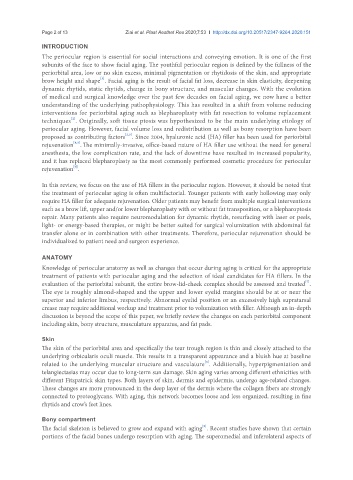Page 610 - Read Online
P. 610
Page 2 of 13 Ziai et al. Plast Aesthet Res 2020;7:53 I http://dx.doi.org/10.20517/2347-9264.2020.151
INTRODUCTION
The periocular region is essential for social interactions and conveying emotion. It is one of the first
subunits of the face to show facial aging. The youthful periocular region is defined by the fullness of the
periorbital area, low or no skin excess, minimal pigmentation or rhytidosis of the skin, and appropriate
[1]
brow height and shape . Facial aging is the result of facial fat loss, decrease in skin elasticity, deepening
dynamic rhytids, static rhytids, change in bony structure, and muscular changes. With the evolution
of medical and surgical knowledge over the past few decades on facial aging, we now have a better
understanding of the underlying pathophysiology. This has resulted in a shift from volume reducing
interventions for periorbital aging such as blepharoplasty with fat resection to volume replacement
[2]
techniques . Originally, soft tissue ptosis was hypothesized to be the main underlying etiology of
periocular aging. However, facial volume loss and redistribution as well as bony resorption have been
[2,3]
proposed as contributing factors . Since 2004, hyaluronic acid (HA) filler has been used for periorbital
[4,5]
rejuvenation . The minimally-invasive, office-based nature of HA filler use without the need for general
anesthesia, the low complication rate, and the lack of downtime have resulted in increased popularity,
and it has replaced blepharoplasty as the most commonly performed cosmetic procedure for periocular
[6]
rejuvenation .
In this review, we focus on the use of HA fillers in the periocular region. However, it should be noted that
the treatment of periocular aging is often multifactorial. Younger patients with early hollowing may only
require HA filler for adequate rejuvenation. Older patients may benefit from multiple surgical interventions
such as a brow lift, upper and/or lower blepharoplasty with or without fat transposition, or a blepharoptosis
repair. Many patients also require neuromodulation for dynamic rhytids, resurfacing with laser or peels,
light- or energy-based therapies, or might be better suited for surgical volumization with abdominal fat
transfer alone or in combination with other treatments. Therefore, periocular rejuvenation should be
individualized to patient need and surgeon experience.
ANATOMY
Knowledge of periocular anatomy as well as changes that occur during aging is critical for the appropriate
treatment of patients with periocular aging and the selection of ideal candidates for HA fillers. In the
[7]
evaluation of the periorbital subunit, the entire brow-lid-cheek complex should be assessed and treated .
The eye is roughly almond-shaped and the upper and lower eyelid margins should be at or near the
superior and inferior limbus, respectively. Abnormal eyelid position or an excessively high supratarsal
crease may require additional workup and treatment prior to volumization with filler. Although an in-depth
discussion is beyond the scope of this paper, we briefly review the changes on each periorbital component
including skin, bony structure, musculature apparatus, and fat pads.
Skin
The skin of the periorbital area and specifically the tear trough region is thin and closely attached to the
underlying orbicularis oculi muscle. This results in a transparent appearance and a bluish hue at baseline
[8]
related to the underlying muscular structure and vasculature . Additionally, hyperpigmentation and
telangiectasias may occur due to long-term sun damage. Skin aging varies among different ethnicities with
different Fitzpatrick skin types. Both layers of skin, dermis and epidermis, undergo age-related changes.
These changes are more pronounced in the deep layer of the dermis where the collagen fibers are strongly
connected to proteoglycans. With aging, this network becomes loose and less organized, resulting in fine
rhytids and crow’s feet lines.
Bony compartment
[9]
The facial skeleton is believed to grow and expand with aging . Recent studies have shown that certain
portions of the facial bones undergo resorption with aging. The superomedial and inferolateral aspects of

